Utah’s landscapes are alive with the songs of wrens, from bustling wetlands to rugged desert canyons. These small, energetic birds enchant birdwatchers with their lively movements and melodious calls, making each outing a chance for discovery.
Each wren species in Utah has its own story—whether the tiny Winter Wren darting through dense forests, the Marsh Wren hidden among cattails, or the bold Cactus Wren perched on desert shrubs. Observing them offers a window into the state’s rich avian diversity.
Spring and summer are the best times to see these wrens in action. Their vocal displays, curious behaviors, and intricate nests provide endless fascination for passionate birders exploring Utah’s varied habitats.
Different Types of Wrens Found in Utah
House Wren (Troglodytes aedon)
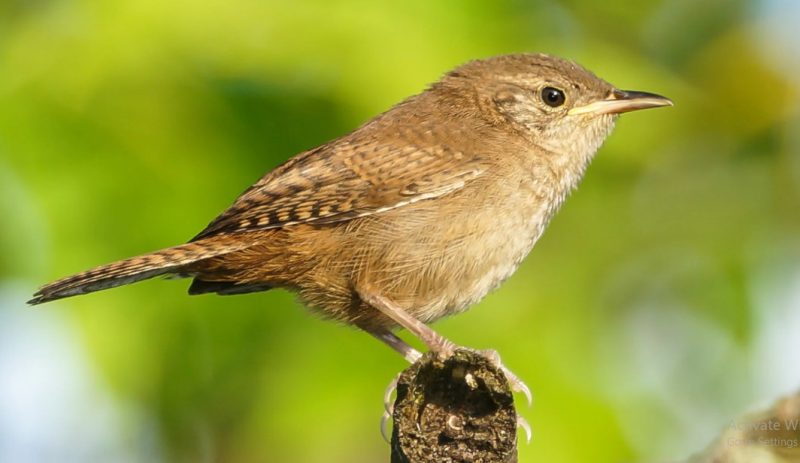
The House Wren is a small songbird, measuring about 4–4.3 inches (10–11 cm) in length and weighing around 0.35–0.42 ounces (10–12 g). Its plumage is mostly warm brown, with subtle barring on the wings and tail, and a slightly paler underbelly. The tail is short and often held upright. Its song is lively and complex, consisting of rapid trills and repeated phrases, especially during the breeding season.
House Wrens are highly adaptable and can be found in a wide variety of habitats, including open woodlands, shrublands, gardens, and suburban areas. They are cavity nesters, using tree holes, crevices, or birdhouses, and line their nests with twigs, grasses, and feathers. This adaptability allows them to thrive across much of Utah, including urban settings.
Their diet primarily consists of small insects, spiders, and larvae, but they will occasionally eat seeds. House Wrens forage actively, hopping through shrubs, low branches, or on the ground, and are known for their energetic movements and curiosity. They play an important role in controlling insect populations in their habitats.
During breeding, male House Wrens are very territorial. They sing loudly to defend their nesting area and may even remove eggs or nestlings of other cavity-nesting birds to reduce competition. Females choose sites carefully, often inspecting multiple cavities before laying eggs, which typically number 4–8 per clutch.
Migration patterns vary across the species’ range. House Wrens in Utah are usually summer residents, arriving in spring and leaving by late summer or early fall. Their ability to occupy a wide range of habitats, combined with their energetic behavior and cheerful song, makes them one of the most familiar wrens to birdwatchers in the region.
Winter Wren (Troglodytes hiemalis)

The Winter Wren is tiny, measuring only 3.5–4 inches (9–10 cm) with a very short tail that is almost always cocked upward. Its plumage is dark brown with fine barring on the wings, tail, and flanks. The underparts are lighter brown, and the bird has subtle pale markings near the eyebrows. Despite its small size, its song is surprisingly loud, consisting of rapid, bubbling trills and warbles.
This species prefers dense, coniferous forests and heavily wooded areas, often near streams or moist ravines. In Utah, they are most commonly found in mountainous regions where thick understory provides cover. Winter Wrens are very secretive, moving quickly through dense vegetation, making them hard to spot despite their vocal presence.
Winter Wrens are insectivorous, feeding on beetles, ants, spiders, and other small invertebrates. They often forage on the forest floor under leaf litter or along mossy logs, and occasionally hang upside down on branches to reach hidden prey. Their constant movement and probing make them highly efficient hunters.
During the breeding season, Winter Wrens construct dome-shaped nests low to the ground or in natural cavities, using moss, grass, and feathers. Females usually lay 5–7 eggs, which hatch after about two weeks. Males are persistent singers, maintaining complex territories throughout the spring and summer.
Winter Wrens are migratory in Utah, typically arriving in late spring to breed and leaving by fall. Their small size, cryptic coloration, and energetic behavior make them a rewarding species for dedicated birdwatchers, who often rely on their song to locate them in thick forest habitats.
Bewick’s Wren (Thryomanes bewickii)
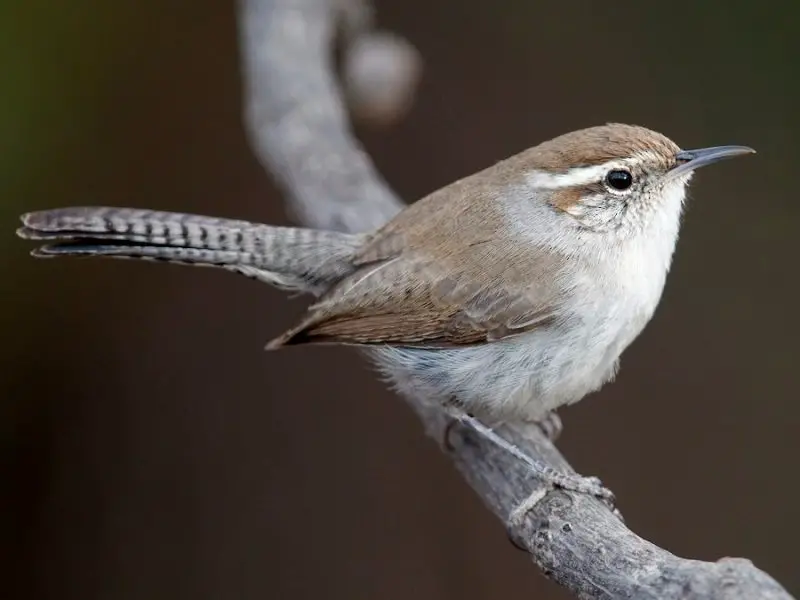
Bewick’s Wren is slightly larger than the House Wren, measuring 5–6 inches (12–15 cm) with a long, often upright tail marked with fine barring. Its plumage is warm brown on the upperparts and pale gray on the underparts. A striking feature is the bold white eyebrow stripe, which helps distinguish it from other wrens in Utah.
This species prefers brushy habitats, open woodlands, and edges of deserts or farmland. They are often seen perched conspicuously on fences, shrubs, or low trees. Bewick’s Wrens are cavity nesters and frequently use old woodpecker holes, crevices, or nest boxes, lining the nest with grass, bark, and feathers.
Their diet consists mainly of insects and spiders, but they will sometimes consume small fruits or seeds. They are active foragers, hopping along branches and probing bark crevices, often flicking their tail to maintain balance. Their vocalizations include a varied, melodious song used for communication and territorial defense.
During breeding, males vigorously defend territories and perform song displays to attract females. Clutches usually contain 4–7 eggs, and both parents participate in feeding the chicks. Bewick’s Wrens are known for their inquisitive nature and can often be approached more closely than other wren species.
In Utah, Bewick’s Wrens are generally resident year-round, although some populations may show local movements depending on food availability. Their adaptability to semi-arid regions, distinctive song, and active behavior make them a favorite among local birdwatchers.
Marsh Wren (Cistothorus palustris)
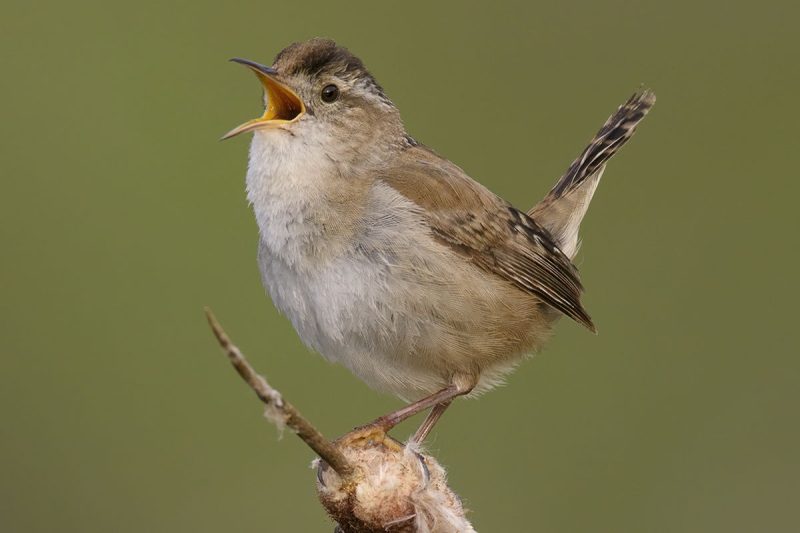
The Marsh Wren is a small wren, about 4–5 inches (10–13 cm) long, with a compact body and short, often cocked tail. Its plumage is dark brown on the back with fine black streaks and a pale buff underbelly. A distinctive feature is its white eyebrow stripe, which contrasts with a dark face mask. Its song is a bubbly, gurgling series of trills and rattles, often delivered from reeds or shrubs.
Marsh Wrens are strongly associated with wetlands. In Utah, they are found in marshes, ponds, and wet meadows, often hiding among cattails, reeds, and dense vegetation. Their nests are small, globular structures built in reeds or low shrubs, lined with grasses and feathers. These nests are often stacked close together, creating dense colonies.
Their diet mainly consists of insects, spiders, and small aquatic invertebrates. Marsh Wrens forage actively among reeds and grasses, frequently clinging to vertical stems or hopping across floating vegetation. They play a role in controlling insect populations in wetland ecosystems.
During breeding, males are highly territorial and may build several “dummy” nests within their territory to attract females. Females choose one nest for laying eggs, usually 4–7 per clutch. Both parents participate in feeding the chicks, which fledge after about two weeks.
Marsh Wrens are migratory in Utah, typically arriving in spring and leaving by late summer or early fall. Their preference for dense wetland vegetation, distinctive bubbly song, and energetic behavior make them a rewarding species for birdwatchers visiting Utah’s marshes and riparian zones.
Cactus Wren (Campylorhynchus brunneicapillus)
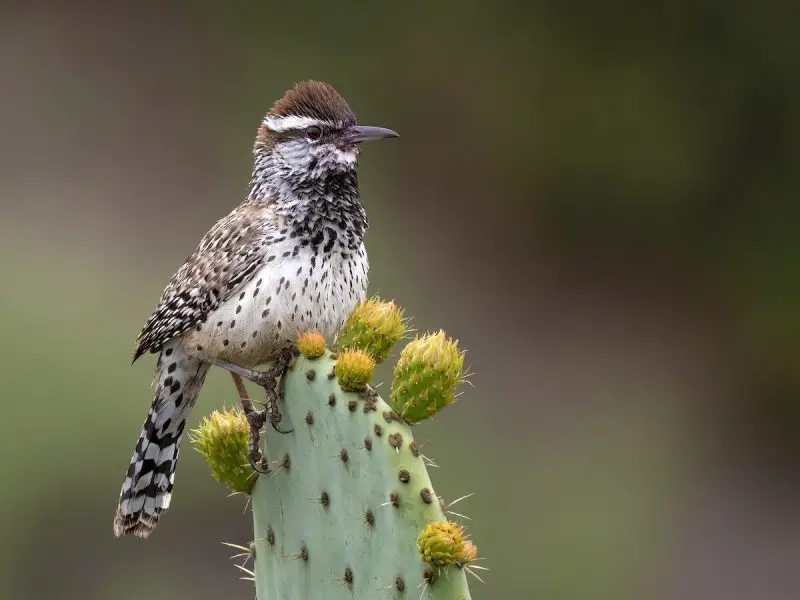
The Cactus Wren is the largest wren in North America, measuring 7–8 inches (18–20 cm) long with a robust body and long tail. Its plumage is mottled brown with white spots on the chest and bold white eyebrows that make it easily recognizable. Its song is a loud, harsh series of chattering notes, often heard echoing through desert landscapes.
This species is strongly associated with arid environments. In Utah, it is typically found in desert scrub, dry washes, and areas with abundant cacti, especially cholla and prickly pear. Cactus Wrens are ground foragers but also build large, dome-shaped nests in cactus or thorny shrubs, providing protection from predators.
Cactus Wrens primarily eat insects, spiders, and occasionally small lizards or seeds. They forage on the ground or low vegetation, using their strong bills to flip over debris and probe crevices. Their adaptability to harsh desert conditions makes them a prominent part of the ecosystem.
During breeding, males are territorial and defend their nests vigorously. They may maintain several nests, with females selecting one for egg-laying. Clutch sizes range from 3–6 eggs, and both parents feed the young until fledging.
Cactus Wrens are generally resident in Utah, remaining in their territories year-round. Their striking appearance, bold behavior, and characteristic song make them one of the most iconic desert birds, easily spotted and identified by both novice and experienced birders.
Rock Wren (Salpinctes obsoletus)
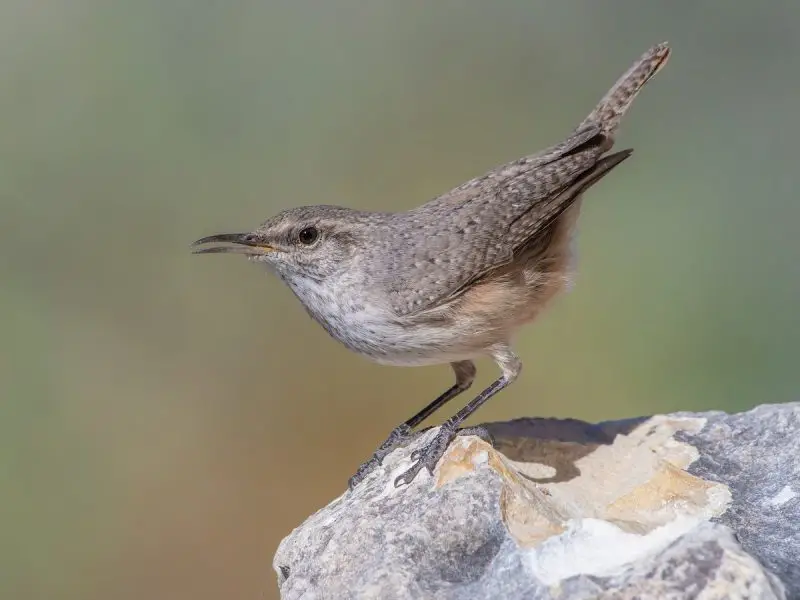
The Rock Wren is a medium-sized wren, about 5–6 inches (12–15 cm) long, with a long tail and slender body. Its plumage is gray-brown on the back with faint streaks, and the underparts are pale gray or buff. A subtle white eyebrow stripe is present, and the tail often flicks up while the bird is perched on rocks. Its song is a series of high-pitched trills and whistles, often delivered from exposed perches.
Rock Wrens inhabit rocky slopes, canyons, cliffs, and talus fields, preferring areas with scattered boulders and sparse vegetation. In Utah, they are commonly seen in mountainous regions and desert canyons. They use crevices in rocks for nesting, lining the nests with grass, feathers, and small twigs.
Their diet is primarily insects and spiders, which they forage for on rocky surfaces or under stones. They are agile foragers, hopping between rocks and probing crevices with their bills. Their foraging behavior is well adapted to steep and rugged terrain.
During breeding, males establish territories and sing from prominent rock perches. Clutch sizes usually range from 4–6 eggs. Both parents take part in feeding the chicks, which fledge after roughly two weeks. Rock Wrens are highly territorial, especially in areas with limited nesting sites.
Rock Wrens are mostly resident in Utah, although some may move to lower elevations during harsh winters. Their preference for rocky habitats, striking song, and distinctive tail-flicking behavior make them a favorite for birdwatchers exploring Utah’s canyons and high desert landscapes.
Best Time and Places to Observe Wrens in Utah
Wrens can be observed throughout Utah, but the timing and location vary depending on the species. The House Wren, Bewick’s Wren, and Rock Wren are generally most active during the spring and summer months when they are breeding. Early morning and late afternoon are ideal times for observation, as wrens are highly vocal and actively foraging during these periods.
For Winter Wrens, dense coniferous forests in the mountains are the best locations. They are secretive and prefer thick understory, so listening for their rapid, bubbling song is often more effective than visual spotting. Late spring and summer offer the best chances, particularly in the higher elevations of northern Utah.
Marsh Wrens are best seen in wetlands, marshes, and riparian zones. Tall reeds and cattails provide their preferred habitat, and they are most easily observed during the breeding season from April to July. Using binoculars to scan the reeds is recommended, as these wrens often remain hidden while singing.
Cactus Wrens are most visible in arid desert regions with abundant cacti. Spring and early summer are the best times, as this is their breeding period and they are more active and vocal. Observing them from a safe distance is important due to their nesting in thorny cacti.
Rock Wrens are found on rocky slopes, cliffs, and canyon areas. Spring and early summer provide optimal opportunities to see them singing from exposed perches. They are highly territorial and often visible on rocks, making them easier to spot than more secretive species.
FAQs about Wrens in Utah
What types of wrens can be found in Utah?
Utah is home to six common wrens: House Wren, Winter Wren, Bewick’s Wren, Marsh Wren, Cactus Wren, and Rock Wren. Each species prefers specific habitats ranging from forests and wetlands to deserts and rocky areas.
When is the best time to see wrens in Utah?
The best time is generally spring and summer during the breeding season. Early mornings and late afternoons are ideal, as wrens are most active and vocal during these hours.
Where are the best locations to observe each wren species?
House and Bewick’s Wrens can be found in suburban areas, brushlands, and open woodlands. Winter Wrens prefer dense conifer forests. Marsh Wrens inhabit wetlands and cattail marshes. Cactus Wrens live in desert scrub with abundant cacti, while Rock Wrens are found in rocky slopes and canyon areas.
How can I identify wrens in the wild?
Wrens are small, active birds with distinct songs. Key identification features include size, coloration, tail posture, and the presence of eyebrow stripes. Listening for their vocalizations is often more reliable than spotting them visually.
Are wrens migratory in Utah?
Some wrens, like Winter Wrens and Marsh Wrens, are migratory, typically arriving in spring and leaving by late summer or early fall. House Wrens, Bewick’s Wrens, Rock Wrens, and Cactus Wrens are usually year-round residents, though local movements may occur depending on food availability.






